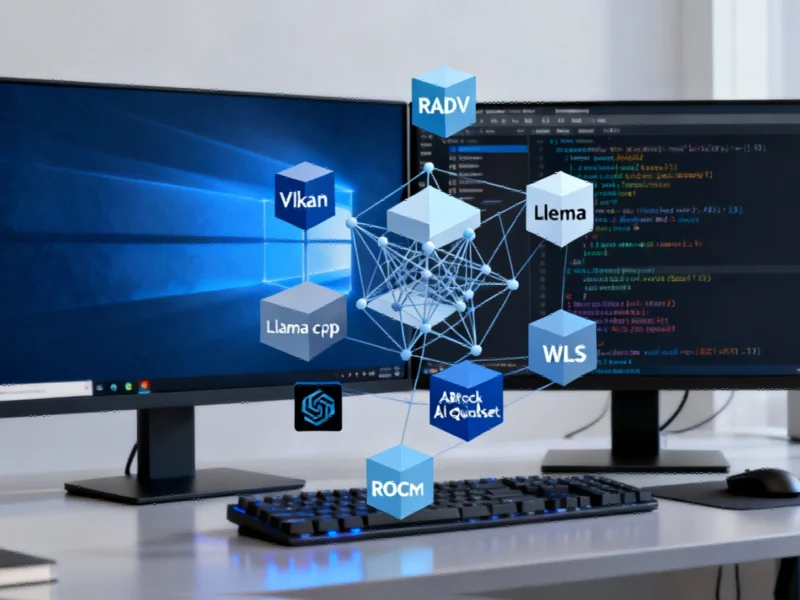A Valve developer has delivered a significant performance enhancement to the RADV Vulkan driver that promises to substantially improve the experience for AI applications like Llama.cpp running on Linux systems. This improvement comes as the broader technology ecosystem continues to push boundaries in AI accessibility and performance across different platforms.
The RADV Vulkan driver improvements represent a crucial advancement for developers and users working with AI models on Linux-based systems. Valve’s ongoing commitment to open-source graphics drivers continues to pay dividends for the broader computing ecosystem, particularly as AI workloads become increasingly demanding of graphics processing capabilities.
Technical Breakthrough for AI Computing
The latest contributions focus on optimizing memory management and shader compilation within the RADV driver, specifically targeting the types of operations commonly used by AI inference engines. For applications like Llama.cpp, which rely heavily on efficient memory access patterns and parallel processing capabilities, these optimizations could translate to measurable performance gains in both training and inference scenarios.
The timing of these improvements coincides with growing industry momentum around AI hardware and software standardization. Recent developments in the hardware space, including Arm’s participation in the Open Compute Project, suggest a broader industry push toward more open and interoperable AI infrastructure. This collaborative approach mirrors the open-source philosophy that has driven RADV’s development from its inception.
Cross-Platform AI Ecosystem Evolution
As AI applications become more pervasive, the tools and frameworks supporting them continue to evolve across operating systems and hardware platforms. The RADV improvements arrive alongside other significant developments in the AI software landscape, including Google’s new corporate AI tools that aim to simplify enterprise AI adoption. These parallel developments highlight the competitive yet complementary nature of AI infrastructure development across different technology segments.
The hardware landscape is also seeing rapid innovation to support these software advancements. Recent product launches like the AMD-powered ROG NUC gaming mini-PC from ASUS demonstrate how consumer and professional hardware are increasingly being designed with AI workloads in mind. These systems stand to benefit directly from driver-level optimizations that improve AI application performance.
Industry-Wide Implications
The RADV Vulkan driver improvements arrive at a critical juncture for the AI hardware ecosystem. Recent reports about AMD Zen 5 processors exhibiting RDSEED instruction enhancements suggest that both hardware and software layers are simultaneously evolving to better support demanding computational workloads, including AI inference and training tasks.
What makes this development particularly noteworthy is how it demonstrates the continued relevance of open-source driver development in an era dominated by proprietary AI solutions. By improving the fundamental graphics infrastructure that underpins many AI applications, Valve’s contributions help ensure that open platforms remain competitive for cutting-edge computational workloads.
Future Outlook
Looking ahead, these RADV Vulkan driver enhancements are likely to have ripple effects throughout the AI development ecosystem. As more developers gain access to improved performance on open-source graphics drivers, we can expect to see increased innovation in AI applications targeting Linux platforms. The combination of hardware advancements, software optimizations, and growing industry collaboration suggests that the AI performance landscape will continue to evolve rapidly in the coming months.
The convergence of these developments—from driver-level optimizations to hardware innovations and corporate AI tooling—paints a picture of an industry maturing rapidly to meet the growing demands of artificial intelligence workloads. For developers working with tools like Llama.cpp, these improvements represent tangible progress toward more accessible and performant AI computing across different platforms and price points.
Based on reporting by {‘uri’: ‘phoronix.com’, ‘dataType’: ‘news’, ‘title’: ‘Phoronix’, ‘description’: ‘Founded by @MichaelLarabel in 2004, Phoronix is the largest #opensource news & #Linux hardware reviews site + Phoronix Test Suite + @OpenBenchmark + @Phoromatic’, ‘location’: {‘type’: ‘country’, ‘geoNamesId’: ‘1814991’, ‘label’: {‘eng’: ‘China’}, ‘population’: 1330044000, ‘lat’: 35, ‘long’: 105, ‘area’: 9596960, ‘continent’: ‘Asia’}, ‘locationValidated’: False, ‘ranking’: {‘importanceRank’: 340933, ‘alexaGlobalRank’: 58871, ‘alexaCountryRank’: 44554}}. This article aggregates information from publicly available sources. All trademarks and copyrights belong to their respective owners.



